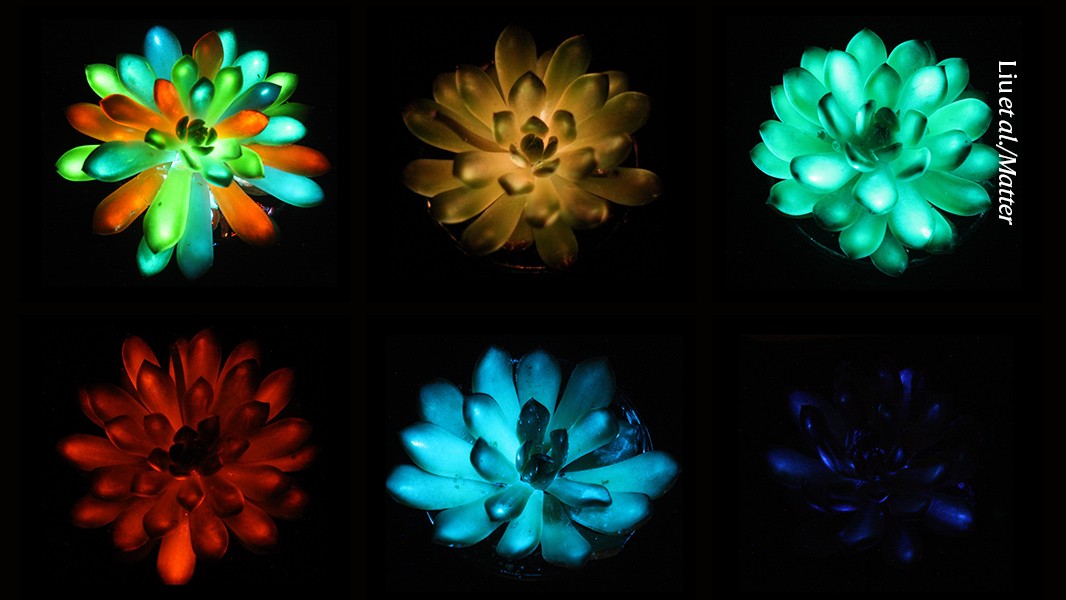Glow-in-the-dark houseplants shine in rainbow of colours

Succulents become rechargeable night lights after injection with tiny phosphor particles
University students might soon have something other than black-light posters to brighten their dorm rooms. Researchers have created glow-in-the-dark plants by injecting succulents with materials similar to those that make the posters light up. The fleshy plants shine as brightly as a night light, and can be made to do so in a wide variety of colours — a first for glowing houseplants, according to the team.
The researchers, led by Xuejie Zhang, a materials scientist at the South China Agricultural University in Guangzhou, describe today how they produced the plants in the journal Matter1. They have applied for a patent on the technology, which they hope will lead to decorative installations and living lighting.
The idea of making glowing plants has captivated scientists since the late 1980s, when researchers made the first bioluminescent plant2 by inserting a gene from a firefly (Photinus pyralis) into a type of tobacco (Nicotiana tabacum). This work laid the foundation for the first genetically engineered luminescent houseplant to come on the market in the United States, last year. The biotechnology firm Light Bio in Sun Valley, Idaho, sells the petunia (Petunia hybrida), which glows a very faint green thanks to genes from a light-emitting mushroom.
Leafy greens … and blues and reds
Unlike the petunia, which emits light through chemical reactions in its cells, the succulent glows because of materials injected into its leaves. These materials — phosphor particles made of strontium and aluminium dosed with other metals — absorb energy from light at one wavelength, store some of that energy and then slowly re-emit it at a different wavelength for several hours. For instance, one material the scientists injected into their succulents absorbs ultraviolet and blue light, and re-emits it as green light.
This type of ‘afterglow’ phosphor is used in glow-in-the-dark toys and paints, and as an imaging tracer for laboratory animals. Whereas genetically engineered bioluminescent plants are, so far, limited in the range of colours they emit, afterglow phosphors span a wide variety of hues, including red and blue, and they can be combined to produce a white glow.

This video shows how the tiny phosphor particles spread through the succulent leaves after they are injected.Credit: Liu et al./Matter
The researchers purchased phosphors containing strontium aluminate and ground them down to particles of various sizes before injecting them into an assortment of plants. They found that particles around 7 micrometres in diameter glowed brighter than did nanoparticles in plants, and were able to fill up the interior tissues of succulent leaves for a stronger, more uniform glow. By contrast, plants with simple leaf structures, such as tobacco plants and pak choi, emitted a more patchy glow.
The plant favoured by the team is the succulent Echevaria ‘Mebina’, a common houseplant that grows rosettes of dense, fleshy leaves. To make every leaf glow, the researchers had to inject each one with phoshor particles, a process that takes about ten minutes. The luminescence — which the team generated in hues of blue-green, blue-violet, green, red and white — lasted as long as 120 minutes after exposing the plant to tailored wavelengths of light or sunlight, and could be triggered again and again over the 10 days of the study.
Enjoying our latest content?
Login or create an account to continue
- Access the most recent journalism from Nature's award-winning team
- Explore the latest features & opinion covering groundbreaking research
or
Sign in or create an accountdoi: https://doi.org/10.1038/d41586-025-02740-2
This story originally appeared on: Nature - Author:Katherine Bourzac

















